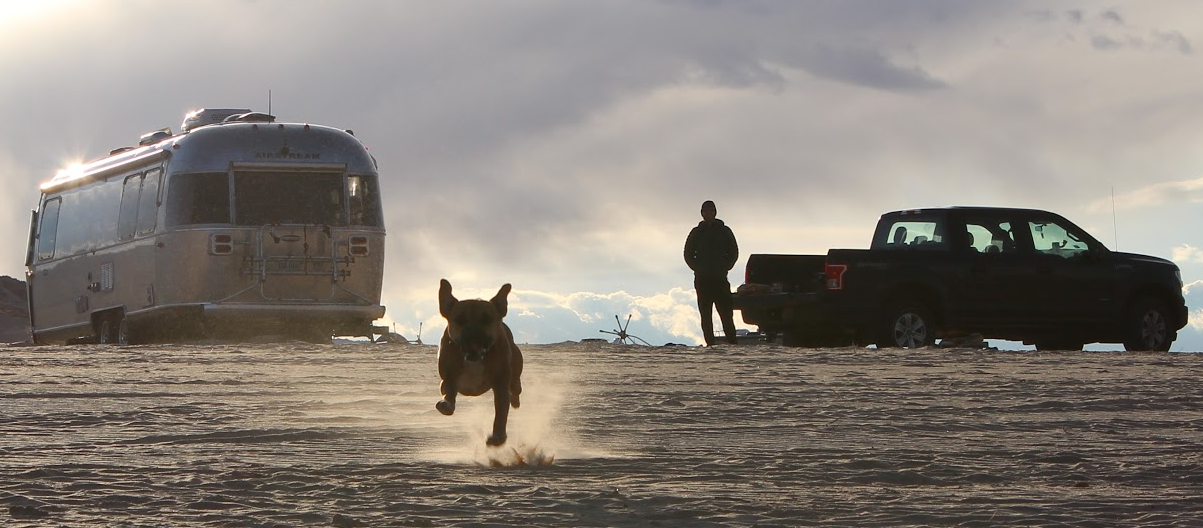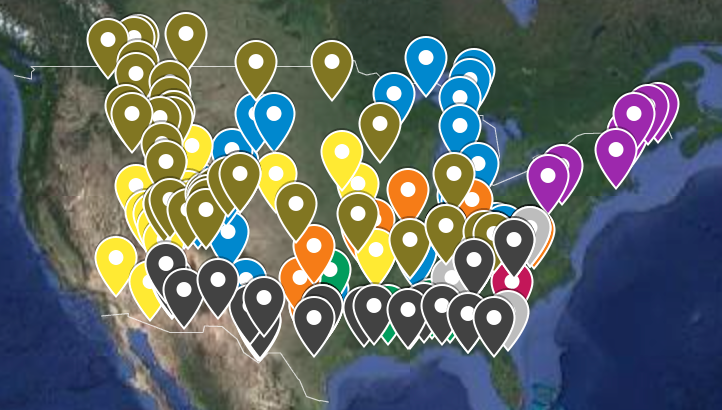
We are very lucky that Bugsy is a great traveler! She’s happy as a clam sleeping on her comfy dog bed in a crate in the car, and when we leave her in the Airstream when we go out on the town, she’ll lounge on the humans’ bed and watch the campground world go by out of the bedroom window.
Travel can be hard on a pet, and it’s important to be prepared and practice with short trips before embarking (hee) upon a long trip to be sure your dog feels safe and understands what’s going on. Here are some of our best tips for taking your dog on an extended road trip:
On the Road
Packing for Your Dog
When packing for your dog for a long trip, you’ll need basics like food, worm pills, flea/tick medicine, collars with your phone number, leashes, treats, toys, and a bed. Here’s a post we did on what was in Bugsy’s suitcase when we did our multi-month trip across the country. It will make your life easier if your dog eats a brand of food that you can buy at national pet stores, so you may consider switching if you’re not on a national brand before leaving. We restocked at big pet stores and Tractor Supplys along the way, but if you’ll be in a location for an extended time, you can also order food to your campground. As for medication, talk to your vet before you leave to see if they have a mail order program for refilling prescriptions. I forgot Bugsy’s worm pills when we went to Austin, but was able to order a refill to our campground and keep her on her regular deworming schedule.
While Underway

Sure, it’s lovely to have your dog roaming at will around the car, maybe curled up in your lap while you travel, but to keep your dog safe in case of accident, it’s best to have her restrained while you’re on the road. Bugsy travels in her crate and sleeps peacefully through an entire trip, no matter how long. We haven’t tried the doggy seatbelts on her because of how she likes to change up her sleep positions in strange ways, but we’d like to hear from others who use them. Before setting sail on a long trip, make sure to experiment with different restraint techniques to find the best way to keep your dog safe but comfortable and happy while cruising.
Leaving Your Dog in the Car
I’m sure you know to not close your pet in a hot or cold car. On warm days, cars heat faster and hotter than you may expect, so park in the shade, open windows, and don’t leave your dog in the car if the outside temperature is above the mid-60s. Cold weather can also be dangerous: a car can act as a refrigerator, making the inside temperature even colder than outside. The ASPCA and other groups recommend never leaving your dog in a car, but honestly, that’s not always practical for travelers–we want to bring Bugsy on excursions with us as much as possible, and that often means she’s out and about with us during the day, but waits in the car for a bit in the evening before we head home to the Airstream. The short stay in the car means she gets to spend more time with us overall, so we see it as a good tradeoff.
PLEASE use common sense when deciding if it’s safe to leave your dog in the car, and err on the side of extreme caution. If it is safe to leave your dog in the car–for example, after a mild Spring or Fall day of touring around a town, when it’s time for the adults to get dinner and doggy to have a nap–be sure to have a snack and water in the car to give your dog refreshment before she hits the hay.
Crossing the Border
If you want to take your dog across the border into Mexico or Canada, make sure you know the rules for entry into the foreign country, and reentry back into the States! We took Bugsy into Canada in 2016, and the rules at that time were: Canada didn’t care, but on our way back into the US, the border agent wanted to see proof of her rabies vaccination. Make sure you have the correct paperwork in hand before you are in another country and can’t bring your dog home with you!
At Your Destination

Campground Restrictions
Many campground have restrictions on dog breed and sizes. Read the rules before you book your stay to be sure your dog will be welcomed. Certain breeds are often discriminated against, so if your dog looks like he may be one of those breeds–we’ve seen discrimination against pit bulls, Dobermans, German shepherds, and Rottweilers–carry DNA test results with you to prove otherwise. WE love all those breeds, to be clear, but we’ve stayed places where, sadly, people believe those breeds are bad.
Leaving Your Dog in the Trailer
This is another thing you should practice: if you’re going to leave your dog alone in the trailer, start with a short stint to see how it goes. Bugsy stays in the bedroom when we go out, sprawled on the bed, with the curtains over the bed open for her viewing pleasure, a bowl of water on the floor, and a baby gate blocking her access to the rest of the trailer. (We’re not worried about her getting into anything; we just don’t want her toenails on the leather seats in the dinette area.) Fortunately, she loves to sleep, so has no problem staying at home when we can’t take her along. Be sure your trailer has appropriate climate control to keep your dog comfortable: a trailer, like a car, can heat up quickly on a hot day or become dangerously cold on a cold day, so you’ll need good ventilation and sufficient air conditioning or heat. There are lots of remote trailer temperature monitors on the market; we haven’t tried any, so if you have, please let us know your experience!
Creating a Yard for Your Dog

If your dog is the type who would enjoy it, consider traveling with a pen or fencing to create an enclosed outdoor space where you can relax with your dog. We travel with four of these pens and clip them end-to-end, forming a long single fence which can enclose an area such as a picnic table and fire pit, or wrap in a semicircle against the trailer, with short garden edging fencing blocking the under-trailer escape route. Note that campgrounds will not let you leave your dog outside when you’re not home.
Cleaning Up After Your Dog
Most campgrounds have bags and cans for disposing of dog doo. Please be a good citizen and clean up after your dog! Carry your own supply of bags with you in case you’re in town or at a campground without bags. In the house, we keep a couple hand towels by the door in case we need to wipe muddy paws, and I cannot tell you how much I value my Dustbuster.
Remember Your Dog is a Fellow Traveler

When you’re planning your travel activities, don’t forget to include doggy entertainment. It’s not fair to give the dog a cursory walk in the morning and at night but otherwise leave him in the trailer while the humans are off gallivanting. We try to give Bugsy some real exercise every day–ideally taking her with us on a hike where all three of us are entertained. Remember: a tired dog is a good dog!






